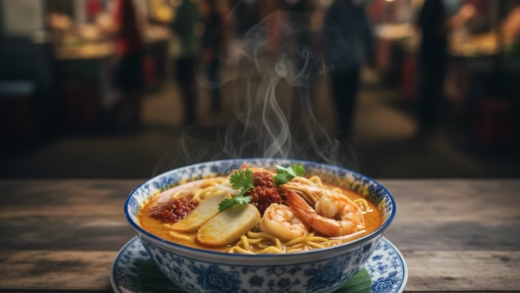Satay Celup

Malaysian Food
Satay Celup – A Malaysian communal hotpot-style dish featuring skewered meats, seafood, and vegetables dipped into rich peanut sauce.
Origin
Category
Street food / Local cuisine / Skewer dish
Appearance
Colorful skewers of meat, seafood, tofu, and vegetables arranged around or in a bubbling pot of thick, creamy peanut sauce.
Ingredients
- Skewers: fish balls, crab sticks, prawns, squid, tofu, cuttlefish, meat slices, vegetables
- Peanut sauce: ground peanuts, coconut milk, spices, chili, soy sauce
- Optional: condiments like sambal, lime, or extra chili paste
Preparation
- Skewer raw or lightly cooked ingredients.
- Heat peanut sauce in a pot until warm and bubbling.
- Dip skewers into the sauce, allowing ingredients to cook.
- Serve immediately while hot.
Equipment
- Large communal pot
- Portable stove (for table use)
- Skewers
- Ladles and tongs
Variations
- Seafood-focused: Emphasizes prawns, squid, and fish balls
- Vegetarian: Tofu, mushrooms, and assorted vegetables only
- Spicy version: Extra chili in peanut sauce
- Regional variations may adjust skewers or sauce consistency
Taste
Savory, nutty, slightly sweet, with optional spiciness depending on the sauce.
Texture
Creamy peanut sauce coats skewers; mixture of chewy (meat, seafood) and crunchy (vegetables).
Aroma
Nutty and savory, with hints of chili, spices, and sometimes a smoky note from pre-grilled skewers.
Sound
Gentle bubbling of the peanut sauce; occasional sizzling of skewers if pre-grilled.
Cultural Significance
Represents communal dining and social interaction; popular in Malacca as both a local favorite and tourist attraction.
Symbolism
Symbolizes sharing, togetherness, and Malacca’s culinary heritage.
Regional Cuisine
Malacca, with popularity extending to Penang, Johor, and Singapore in adapted forms.
Social Context
Enjoyed in groups at street-side stalls or casual restaurants; diners select and cook skewers at the table.
Nutritional Information
High in protein (meat/seafood), moderate in fats (peanut sauce), contains carbohydrates (vegetables, tofu).
Health Benefits
Provides protein, healthy fats from peanuts, fiber, and vitamins from vegetables; moderation advised due to rich sauce.
Dietary Restrictions
Not suitable for nut allergies or vegans (unless modified); check meat sources for halal compliance.
Allergens
Peanuts, seafood, soy (tofu), and possibly gluten (processed ingredients).
Cost
Affordable street food; skewers usually range from 5–15 MYR each depending on ingredients.
Production
Skewers are freshly prepared daily; peanut sauce made in batches and kept warm for diners.
Sustainability
Using locally sourced ingredients and portion control reduces waste; seafood selection impacts sustainability.
Availability
Widely available in Malacca; select restaurants in Penang, Johor, and Singapore also serve variations.
History
Originated in Malacca, adapting traditional satay with a communal dipping approach. Popularized in the 20th century as a casual street food experience.
Anecdotes
Locals often reminisce about enjoying Satay Celup with friends and family, choosing favorite skewers while chatting and sharing stories.
How to Prepare
- Select or prepare skewers of choice.
- Heat peanut sauce in a pot until warm and bubbling.
- Dip skewers individually and cook to desired doneness.
- Serve immediately with optional condiments like sambal or lime.
FAQ
Q: Can I make Satay Celup at home?
A: Yes, with pre-made peanut sauce and store-bought skewers; the communal experience is part of the charm.
Q: How spicy is it?
A: It depends on the chili content in the peanut sauce; often mild to medium, but can be made spicy.
Q: How long does it take to cook each skewer?
A: Usually 2–5 minutes depending on size and type of ingredient.
Q: Is it suitable for vegetarians?
A: Yes, if using only tofu, mushrooms, and vegetables with vegetarian sauce.















Comments are closed.